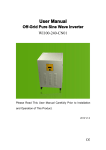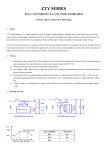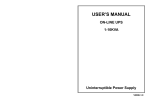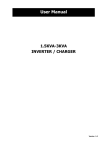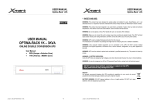Download 52SJ user manual us WESCO
Transcript
Frequently asked questions Q. Does the stepped square-wave shape adversely affect the load in any way? A. No. Although there is some harmonic content which is negligible under load, the DPI is only supplying this wave shape during a dip or sag and is therefore only present for very short periods of time. Heat build-up and other possible side effects need not be considered and the type of loads generally present in control circuits will function normally. Remember that it is not just a square wave; the step has been created so the peak and the RMS voltage of this wave shape are the same as that of a sinewave. Q. How do I select the correct size DPI for an application? A. The three methods to determine the correct size are outlined on a separate sheet. We recommend that the DPI be oversized by at least 20-30% in terms of power to provide a safe operating margin and allow for the future addition of components to the load. Also, the support time must be taken into account. The standard units are rated at their maximum load capacity for one second. Q. What if I require a longer ride-through time? A. Two options are available. The first, is to use the next size unit up from the standard selection. e.g. A 3kVA unit supplying a 1kVA load will be able to provide ride-through for three seconds. The time and the load are inversely proportional. The second is to add additional storage capacitors. This is a custom requirement that is available on request. Q. What if the load has a higher power factor than normal for Motor Control Centers and Switchboards? A. Generally, these loads are inductive as they consist of contactors, relays and starters and therefore the power factor is a relatively low value between 0.15 and 0.3. Should the control circuitry also include PLC’s, power supplies and other ‘real power’ loads, they need to be considered when sizing a unit. Once again, two options are available; one, is to use the next size unit up from the standard selection and the second is a custom unit with additional storage capacitors. Q. What if I need a higher power unit? e.g. 5kVA or 6kVA. A. This is a custom requirement that may be available on special order, please contact our sales department. Q. Do I use many small units or one large one? A. That depends on the configuration of the control circuitry. Many small control transformers individually supplying a singe starter or contactor would need an appropriate number of small units and one large control transformer supplying various control items on a common control bus would dictate the use of a single large unit. Q. What if it is not economical to use many small units? A. The controls should be consolidated if possible and the cost of partial rewiring to achieve this, should be evaluated. This way, fewer medium or large units can be installed. However, different timer settings may be required for different loads thereby not allowing the use of a single large unit. The best compromise involves the use of a few medium units whose settings can be adjusted to suit loads which are similar. Q. What are the recommended timer settings? A. This depends on two things: 1) Power quality monitoring studies performed by the customer or utility from which the timer can be set to cover the worst case measured. 2) The inertia of the load. High inertia loads such as conveyors, blowers and fans will run for seconds without slowing significantly and therefore can remain connected for longer periods of time. Low inertia loads, such as pumps, chillers and compressors slow down significantly in short periods of time (300-500 milliseconds) to a point where it is not practical to keep them connected as the entire system may then be out of sync. As most applications are different, our assistance is available to determine specific requirements. DIP-PROOFING TECHNOLOGIES INC. DPI Binder Rev 1.0 Page 1 Frequently asked questions Footnote: Reconnecting the motor (via motor starter or contactor which has dropped out) immediately after a dip is dangerous for the following reason: If the motor has slowed down significantly and dropped out of sync with the returning supply after an interruption, twice the voltage can be present at the motor terminals thereby inducing excessive torque on the shaft and placing undue electrical and mechanical stress on the system. However, if motor connection is maintained during a total interruption, as recommended in various studies, system stress is reduced because the voltage at the motor terminals is reduced to more acceptable levels, due to rapid flux decay, as current is allowed to flow in the secondary of the transformer and/or other parallel loads. Also, if the system is kept connected, this problem is less of a concern under sag conditions because the supply is not out of sync with the load as there is still some voltage present. Q. How much heat does it dissipate? A. Despite the appearance of the housing and the presence of cooling fins, the DPI generates very little heat because it is an off-line system. It does not operate until required. Only the static switch develops some heat as it is in series with the load and is therefore continuously in circuit. Q. How much power is consumed by the unit to keep it operating and the capacitors charged? A. All units consume approximately 25 watts under normal operation. At 120V, this equates to +/- 200 mA, which is insignificant. Q. What type of capacitors are used and what is their lifetime? A. Long-life, computer-grade aluminum electrolytic types made in the US or Japan. A specific version of the manufacturers type was selected based on life-time, ripple current capability and reliability. They are all rated from -40°C to +85°C operating temperature and used under ideal conditions being charged to working voltage and carrying virtually no ripple current. To date, none have been replaced as a result of deterioration since 1990. Predicted life-time is approximately 12 years at 25ºC/77ºF average ambient. Q. Can the capacitors be replaced when necessary without having to replace the entire unit? A. Yes. Although the capacitors are maintenance-free and last a lot longer than batteries, they do have a finite life. Once it has been determined that their capacity has diminished to the point where the up time is too short for the application, we offer a service where the units can be returned for capacitor replacement. Q. How long does it take for the capacitors to recharge after a voltage dip? A. This depends on the duration of the dip and the subsequent level to which they are discharged. Seldom are they totally discharged and therefore in most situations are re-charged to a useable level in less than on second. In the worst case they are fully charged in approximately two seconds. Q. Where and how do I mount or install the DPI? A. Ideally, the unit should be mounted inside the control panel, motor control center or switchboard. Should there be insufficient space, they can be mounted on the outside, on top or wherever else convenient. The unit is mounted using four bolts. A ground stud must be wired to the system grounding point. Q. What about the exposed terminals in the front? A. Fit the terminal cover kit supplied with the unit. This cover provides for mounting a standard 1/2 inch conduit fitting and completely covers the terminals when wiring is complete. Q. What are the environmental constraints and options of the DPI? Page 2 DIP-PROOFING DPI Binder Rev 1.0 TECHNOLOGIES INC. Frequently asked questions A. The maximum specified ambient temperature of the unit is 113°F / 45°C, although they are soak tested (burned in) for 100 hours at 122°F / 50°C. Temperatures exceeding this require the use of a specially housed unit, possibly with cooling. On the lower end of the scale the DPI should operate down town the minimum specified capacitor temperature of -40°C. For explosive environments or where corrosive chemicals and/or excessive moisture is present, the DPI must be mounted in an appropriate enclosure. These are custom requirements and in most cases the work is carried out by the customer or their contractor. Q. Do qualified service personnel need to adjust, maintain, test and service the DPI? A. No. Any competent plant electrician, maintenance supervisor or manager can perform these functions. Other than initial timer settings and other adjustments, the unit requires no maintenance or servicing. Routine testing can be carried out using our tester at one year intervals or whenever necessary or should a unit appear faulty. All relevant instruction are detailed in the Service and Installation Manual. Q. What about faulty units? A. Two possibilities exist here: i) A temporary fault can be rectified by replacing the protection fuse. ii) Should the unit still not operate, it should be returned for repair/exchange. Q. How do I know that the unit is working correctly? A. The most obvious way to determine this is to check if the process which is ‘backed-up’ by the DPI is still running after the usual symptoms/side-effects of a dip, such as the blinking of lights, have been noticed. The next method is to perform a visual check on the unit. If the correct indicators are illuminated according to the Service and Installation Manual under normal conditions, then all is well. Q. What about test equipment? A. A Sag Simulator is available that can be used to generate voltage sags or outages to test that the DPI is functioning correctly. Q. What is the warranty? A. Warranty is one (1) year. Q. Why can I not use a similarly sized UPS for the same purpose? A. For numerous reasons: 1) Smaller, off-line UPS’s are not able to switch over fast enough at the onset of a dip, causing the load to drop out. Many sensitive devices begin to fail in times as short as 1/4 cycle (4 milliseconds) and therefore require the use of a device capable of ultra-fast switch-over. The DPI achieves this in approximately 700 mS (0.7 mS). 2) Many UPS’s do not operate well with inductive loads and low power factors such as those present in switchboards. 3) Due to the high inrush currents associated with relays, contactors and starters, a UPS would need to be oversized to withstand this phenomenon. Since the static switch in the DPI is overrated by 8-10 times in terms of voltage and current for this purpose, an oversized unit does not need to be specified and a unit sized according to the continuous VA rating of the load can be selected. 4) The inclusion of an adjustable timer and variable transfer level in every unit allows for exact control of every application and these items do not need to be combined with a UPS as an aftermarket addition. Without some form of timing device, UPS’s will supply power to the load for an indefinite period of time and for reasons mentioned previously, this can be dangerous. DIP-PROOFING TECHNOLOGIES INC. DPI Binder Rev 1.0 Page 3 Frequently asked questions 5) The problems associated with batteries exist; maintenance, replacement and hazardous waste disposal. 6) They were not designed for industrial robustness. They often require cooling and/or ventilation and the housing is usually thin- walled and not very rugged. Environmental constraints can also limit their application. Q. Why do the smaller DPI’s cost more than comparably sized UPS’s? A. The rand per VA value on the smaller units is lower than that of a UPS because even the smallest DPI includes the features that make it unique. i.e. 1) The use of a more reliable, standby configuration with an ultra-fast transfer time of 700mS. 2) The inclusion of an adjustable ride-through timer and variable transfer level. 3) The use of an overrated static switch avoiding the need to oversize with variable loads. 4) A housing more suited to industrial environments. 5) Negligible long-term costs due to the lack of maintenance. Although the initial cost may be higher, the long-term costs are lower because of the lack of batteries and related maintenance and replacement costs. Q. Does the DPI have any surge protection? A. Yes. To protect the unit; in two places; 1) In the static switch. 2) Across the inverter bridge. The DPI does not offer any protection for the load and does not condition the line. We only concern ourselves with undervoltage as there are numerous filters and similar devices on the market which address the problem of overvoltage. Q. Is there a possibility of resonance between the capacitors and the coils of the starters (i.e. a purely reactive load)? A. The highest resonant frequency (fr ) would be at the highest reactive load. From this it is calculated that for a 500VA unit, fr = 4.75Hz and for a 3kVA unit, fr = 5.5Hz. With the configuration used, any oscillation would only occur if the resonant frequency was higher than the system frequency of 60Hz, which it is not. Also, in a full bridge configuration with free-wheeling diodes, the reactive energy is returned to the capacitor(s) every half cycle in a fully controlled way. Self oscillation cannot occur through the bridge. Q. What approvals and/or safety agency listings does the DPI have? A. Two: 1) DPI’s are UL listed: ref. File # E205817 & Control # 37WJ 2) DPI’s carry the CE mark of conformity: E5091-2:1995-EMC requirements & E5091-1:1993-Safety requirements. Q. Is the DPI patented? A. Patent is pending. A filing date and number have been assigned. Page 4 DIP-PROOFING DPI Binder Rev 1.0 TECHNOLOGIES INC.




